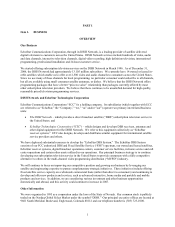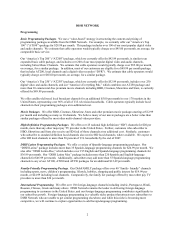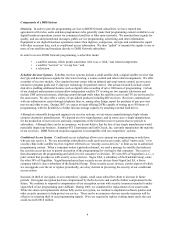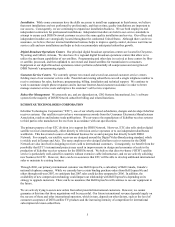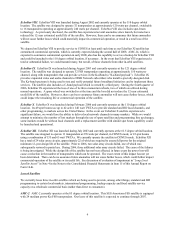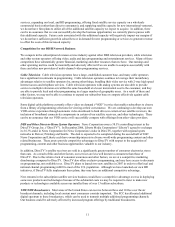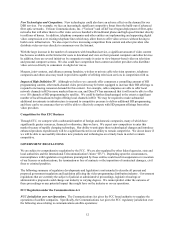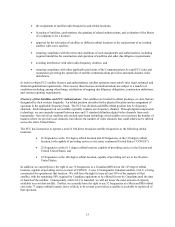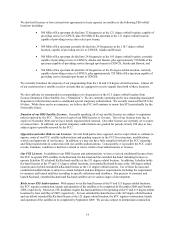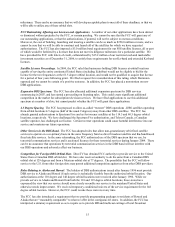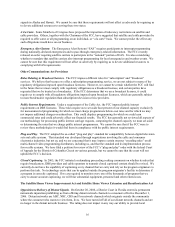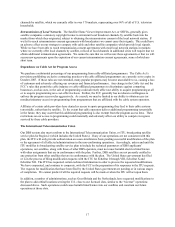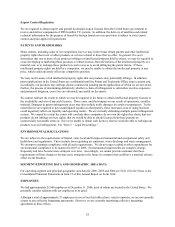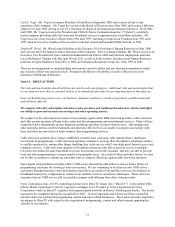Dish Network 2006 Annual Report Download - page 21
Download and view the complete annual report
Please find page 21 of the 2006 Dish Network annual report below. You can navigate through the pages in the report by either clicking on the pages listed below, or by using the keyword search tool below to find specific information within the annual report.11
services, expanding our local, and HD programming, offering fixed satellite service capacity on a wholesale
commercial basis (rather than direct to consumers), and supplying satellite capacity for new international ventures),
we do not have firm plans to utilize all of the additional satellite capacity we expect to acquire. In addition, there
can be no assurance that we can successfully develop the business opportunities we currently plan to pursue with
this additional capacity. Future costs associated with this additional capacity will negatively impact our margins if
we do not have sufficient growth in subscribers or in demand for new programming or services to generate revenue
to offset the costs of this increased capacity.
Competition for our DISH Network Business
We compete in the subscription television service industry against other DBS television providers, cable television
and other system operators offering video, audio and data programming and entertainment services. Many of these
competitors have substantially greater financial, marketing and other resources than we have. Our earnings and
other operating metrics could be materially and adversely affected if we are unable to compete successfully with
these and other new providers of multi-channel video programming services.
Cable Television. Cable television operators have a large, established customer base, and many cable operators
have significant investments in programming. Cable television operators continue to leverage their incumbency
advantages relative to satellite operators by, among other things, bundling their video service with 2-way high speed
Internet access and telephone services. Cable television operators with analog systems are also able to provide
service to multiple television sets within the same household at a lesser incremental cost to the consumer, and they
are able to provide local and other programming in a larger number of geographic areas. As a result of these and
other factors, we may not be able to continue to expand our subscriber base or compete effectively against cable
television operators.
Some digital cable platforms currently offer a video on demand (“VOD”) service that enables subscribers to choose
from a library of programming selections for viewing at their convenience. We are continuing to develop our own
VOD service experience through automatic video downloads to hard drives in certain of our satellite receivers, the
inclusion of broadband connectivity components in certain of our satellite receivers, and other technologies. There
can be no assurance that our VOD service will successfully compare with offerings from other video providers.
DBS and Other Direct-to-Home System Operators. News Corporation owns a 38.5% controlling interest in the
DirecTV Group, Inc. (“DirecTV”). In December 2006, Liberty Media Corporation (“Liberty”) agreed to exchange
its 16.3% stake in News Corporation for News Corporation’s stake in DirecTV, together with regional sports
networks in Denver, Pittsburg and Seattle. The deal is expected to be completed during the second half of 2007.
News Corporation and Liberty each have ownership interests in diverse world-wide programming content and other
related businesses. These assets provide competitive advantages to DirecTV with respect to the acquisition of
programming, content and other business opportunities valuable to our industry.
In addition, DirecTV’s satellite receivers are sold in a significantly greater number of consumer electronics stores
than ours. As a result of this and other factors, our services are less well known to consumers than those of
DirecTV. Due to this relative lack of consumer awareness and other factors, we are at a competitive marketing
disadvantage compared to DirecTV. DirecTV also offers exclusive programming, and may have access to discounts
on programming, not available to us. DirecTV plans to launch two new satellites in 2007 in order to offer local and
national channel programming in HD to most of the U.S. population. Although we have launched our own HD
initiatives, if DirecTV fully implements these plans, they may have an additional competitive advantage.
New entrants in the subscription satellite services business would have a competitive advantage over us in deploying
some new products and technologies because of the substantial costs we may be required to incur to make new
products or technologies available across our installed base of over 13 million subscribers.
VHF/UHF Broadcasters. Most areas of the United States can receive between three and 10 free over the air
broadcast channels, including local content most consumers consider important. The FCC has allocated additional
digital spectrum to these broadcasters, which can be used to transmit multiple additional programming channels.
Our business could be adversely affected by increased program offerings by traditional broadcasters.


